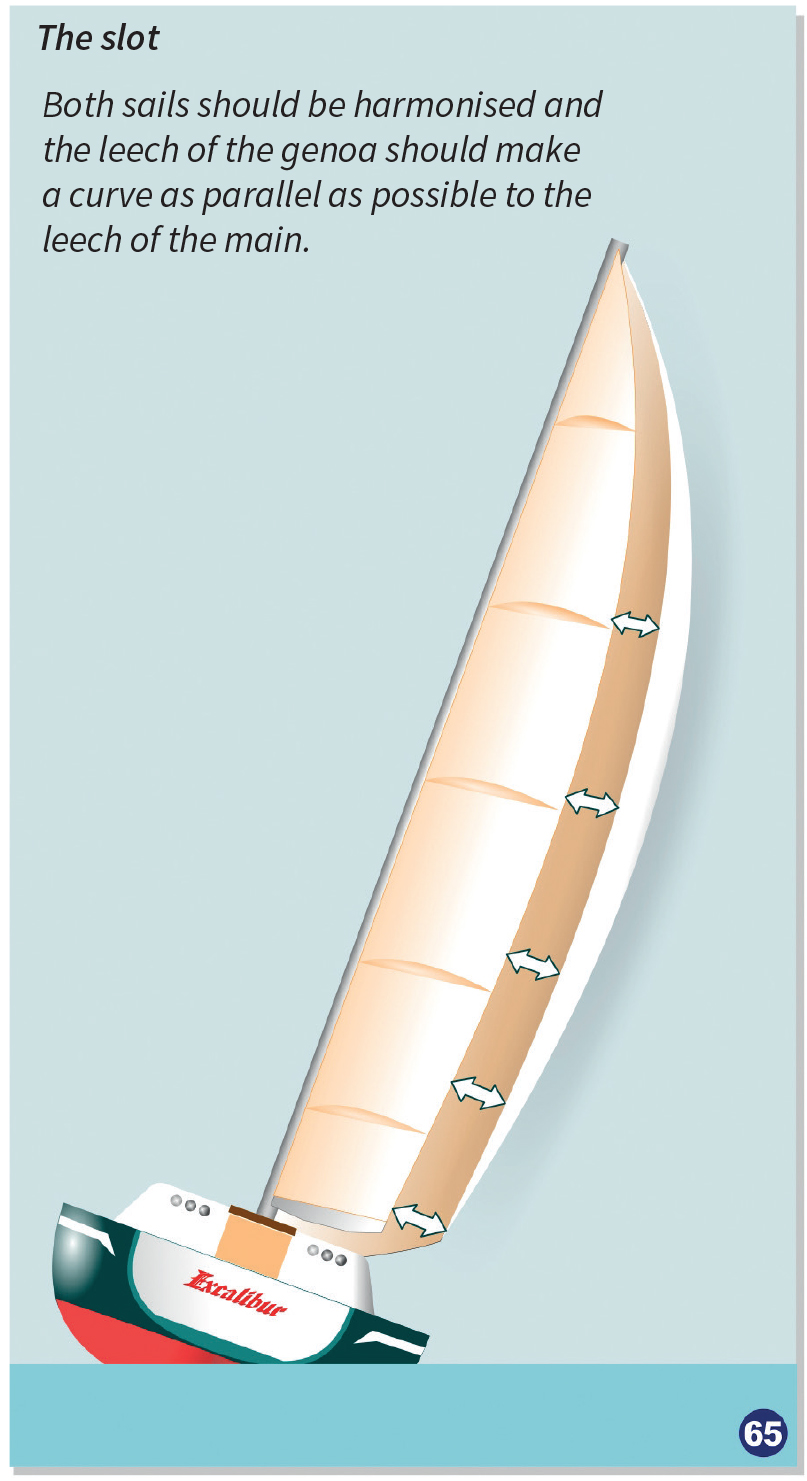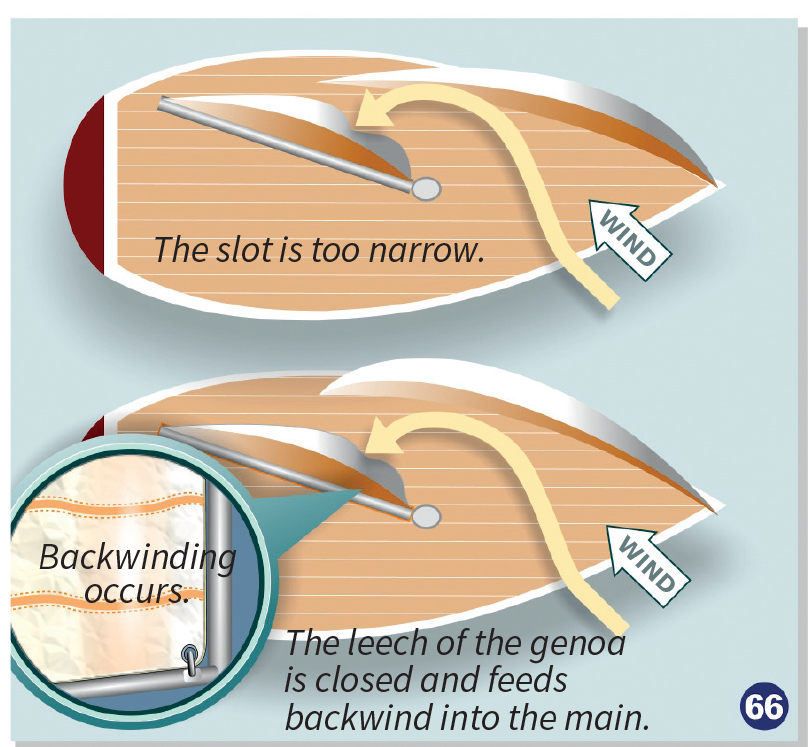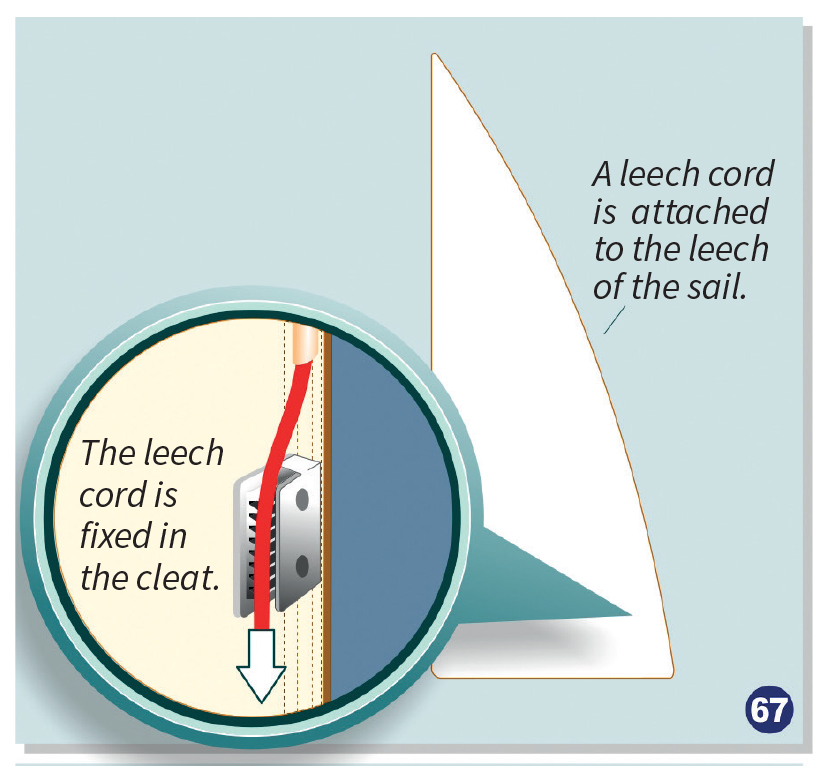Interaction Between Genoa & Mainsail
Book Extract
As shown in Fig.28 (upwash), the headsail greatly affects the airflow across the main.
Headsail and mainsail may therefore be viewed as one entire wing – the main’s leech being the trim flap.
The overlapping area between genoa and main is called the slot. The width of the slot depends on how you trim the sails in relation to each other.
In light and medium winds you should trim the main in such a way that when heading up into the wind:
The luff of the main backwinds evenly from foot to top at the same time as the genoa is luffing (all windward telltales start to flutter simultaneously).
In stronger winds you may backwind the main near the mast in order to keep the boat in balance. If large parts of the sail are backwinded the slot is too narrow, restricting flow. To avoid reefing you may try to:
- Ease the genoa sheet a little
- Add twist (traveller to windward and ease sheet)
- Flatten the main
NB! When the main luffs, it may be caused by a closed genoa leech feeding backwind into the main.If this is the case, you may correct the problem by moving the draft of the genoa forward (tighten halyard) and / or tighten the genoa sheet.
If the slot is too wide, the main will lose the extra drive it gets from the interaction between the sails. You may then try to:
- Ease the mainsheet (more power and speed)
- Tighten the genoa sheet (pointing higher)
- Add depth to the main (more power and speed)
NB! You must, of course, compare all this to what has been said earlier about the genoa and main. It will make it all more complicated, but generally:
- A sail is most efficient on the verge of collapsing
- A sail is more efficient the further out it can be sheeted while still filling
The width of the slot will be at its optimum just when the first backwind appears in the main.


When the leech flutters
You will sometimes see (and hear) that the leech of your sail is fluttering. If the sail has a leech cord, tighten it until the leech just stops fluttering.
Tightening can cause the sail leech to curl or hook to windward. Neither will seriously affect performance but the latter is less irritating and will reduce fraying damage.
Large genoas often have foot tightening cords as well as the common leech cords.
- Tension the leech cord until the fluttering just stops
Low gear
The shape of the sails can be compared to an automobile gear box. Low gearing is used when you need power to accelerate or sail through waves.When you need power more than pointing ability, use full sails with generous twist. Used by racers to accelerate out of a tack. Good for choppy seas and unstable winds.
Low gear or 1st gear:
- Full sails with generous twist and round entries
- Wide groove, full power but not pointing high
Medium gear
This is used when the wind increases without the sea becoming too choppy. You wish to increase boatspeed and at the same time point high. The sails are sheeted harder, flattening the sails, but the entries are still round, keeping the groove relatively wide.
Medium gear or 2nd gear:
- Flatter sails sheeted harder but maintaining a rounded entry
- Medium power and pointing ability
High gear
This is used in ideal conditions with medium winds and flat seas. This allows maximum pointing ability and still maintains good boatspeed. The sails are trimmed flat and sheeted hard for maximum pointing ability. The entry of the genoa is made finer (tight forestay) and the draft is moved aft both on the genoa and mainsail.
High gear or 3rd gear:
- Very flat sails, sheeted very hard, with fine entries and draft aft for maximum pointing ability, but less power
High gear is also used when the wind is very strong and you don’t want to reef. You twist the sails more and ease the sheets a little to de-power the sails.

© Not to be reproduced without written permission from Fernhurst Books Limited.